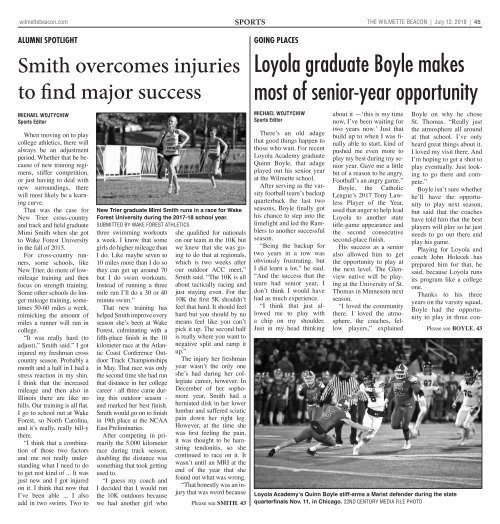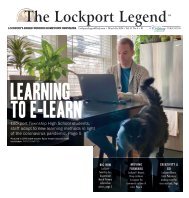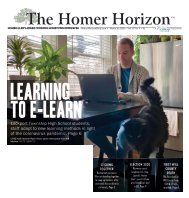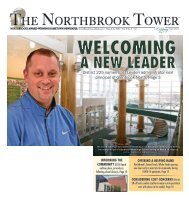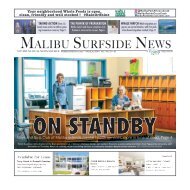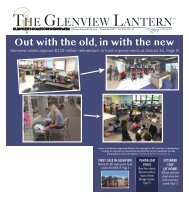WB_071218
Create successful ePaper yourself
Turn your PDF publications into a flip-book with our unique Google optimized e-Paper software.
wilmettebeacon.com SPORTS<br />
the wilmette beacon | July 12, 2018 | 45<br />
Alumni Spotlight<br />
Smith overcomes injuries<br />
to find major success<br />
Michael Wojtychiw<br />
Sports Editor<br />
When moving on to play<br />
college athletics, there will<br />
always be an adjustment<br />
period. Whether that be because<br />
of new training regimens,<br />
stiffer competition,<br />
or just having to deal with<br />
new surroundings, there<br />
will most likely be a learning<br />
curve.<br />
That was the case for<br />
New Trier cross-country<br />
and track and field graduate<br />
Mimi Smith when she got<br />
to Wake Forest University<br />
in the fall of 2015.<br />
For cross-country runners,<br />
some schools, like<br />
New Trier, do more of lowmileage<br />
training and then<br />
focus on strength training.<br />
Some other schools do longer<br />
mileage training, sometimes<br />
50-60 miles a week,<br />
mimicking the amount of<br />
miles a runner will run in<br />
college.<br />
“It was really hard (to<br />
adjust),” Smith said.” I got<br />
injured my freshman cross<br />
country season. Probably a<br />
month and a half in I had a<br />
stress reaction in my shin.<br />
I think that the increased<br />
mileage and then also in<br />
Illinois there are like no<br />
hills. Our training is all flat.<br />
I go to school out at Wake<br />
Forest, so North Carolina,<br />
and it’s really, really hill-y<br />
there.<br />
“I think that a combination<br />
of those two factors<br />
and me not really understanding<br />
what I need to do<br />
to get rest kind of ... It was<br />
just new and I got injured<br />
on it. I think that now that<br />
I’ve been able ... I also<br />
add in two swims. Two to<br />
New Trier graduate Mimi Smith runs in a race for Wake<br />
Forest University during the 2017-18 school year.<br />
Submitted by Wake Forest Athletics<br />
three swimming workouts<br />
a week. I know that some<br />
girls do higher mileage than<br />
I do. Like maybe seven to<br />
10 miles more than I do so<br />
they can get up around 70<br />
but I do swim workouts.<br />
Instead of running a three<br />
mile run I’ll do a 30 or 40<br />
minute swim.”<br />
That new training has<br />
helped Smith improve every<br />
season she’s been at Wake<br />
Forest, culminating with a<br />
fifth-place finish in the 10<br />
kilometer race at the Atlantic<br />
Coast Conference Outdoor<br />
Track Championships<br />
in May. That race was only<br />
the second time she had run<br />
that distance in her college<br />
career - all three came during<br />
this outdoor season -<br />
and marked her best finish.<br />
Smith would go on to finish<br />
in 19th place at the NCAA<br />
East Preliminaries.<br />
After competing in primarily<br />
the 5,000 kilometer<br />
race during track season,<br />
doubling the distance was<br />
something that took getting<br />
used to.<br />
“I guess my coach and<br />
I decided that I would run<br />
the 10K outdoors because<br />
we had another girl who<br />
she qualified for nationals<br />
on our team in the 10K but<br />
we knew that she was going<br />
to do that at regionals,<br />
which is two weeks after<br />
our outdoor ACC meet,”<br />
Smith said. “The 10K is all<br />
about tactically racing and<br />
just staying even. For the<br />
10K the first 5K shouldn’t<br />
feel that hard. It should feel<br />
hard but you should by no<br />
means feel like you can’t<br />
pick it up. The second half<br />
is really where you want to<br />
negative split and ramp it<br />
up.”<br />
The injury her freshman<br />
year wasn’t the only one<br />
she’s had during her collegiate<br />
career, however. In<br />
December of her sophomore<br />
year, Smith had a<br />
herniated disk in her lower<br />
lumbar and suffered sciatic<br />
pain down her right leg.<br />
However, at the time she<br />
was first feeling the pain,<br />
it was thought to be hamstring<br />
tendonitis, so she<br />
continued to race on it. It<br />
wasn’t until an MRI at the<br />
end of the year that she<br />
found out what was wrong.<br />
“That honestly was an injury<br />
that was weird because<br />
Please see Smith, 43<br />
Going Places<br />
Loyola graduate Boyle makes<br />
most of senior-year opportunity<br />
Michael Wojtychiw<br />
Sports Editor<br />
There’s an old adage<br />
that good things happen to<br />
those who wait. For recent<br />
Loyola Academy graduate<br />
Quinn Boyle, that adage<br />
played out his senior year<br />
at the Wilmette school.<br />
After serving as the varsity<br />
football team’s backup<br />
quarterback the last two<br />
seasons, Boyle finally got<br />
his chance to step into the<br />
limelight and led the Ramblers<br />
to another successful<br />
season.<br />
“Being the backup for<br />
two years in a row was<br />
obviously frustrating, but<br />
I did learn a lot,” he said.<br />
“And the success that the<br />
team had senior year, I<br />
don’t think I would have<br />
had as much experience.<br />
“I think that just allowed<br />
me to play with<br />
a chip on my shoulder.<br />
Just in my head thinking<br />
about it —‘this is my time<br />
now, I’ve been waiting for<br />
two years now.’ Just that<br />
build up to when I was finally<br />
able to start, kind of<br />
pushed me even more to<br />
play my best during my senior<br />
year. Gave me a little<br />
bit of a reason to be angry.<br />
Football’s an angry game.”<br />
Boyle, the Catholic<br />
League’s 2017 Tony Lawless<br />
Player of the Year,<br />
used that anger to help lead<br />
Loyola to another state<br />
title-game appearance and<br />
the second consecutive<br />
second-place finish.<br />
His success as a senior<br />
also allowed him to get<br />
the opportunity to play at<br />
the next level. The Glenview<br />
native will be playing<br />
at the University of St.<br />
Thomas in Minnesota next<br />
season.<br />
“I loved the community<br />
there. I loved the atmosphere,<br />
the coaches, fellow<br />
players,” explained<br />
Boyle on why he chose<br />
St. Thomas. “Really just<br />
the atmosphere all around<br />
at that school. I’ve only<br />
heard great things about it.<br />
I loved my visit there. And<br />
I’m hoping to get a shot to<br />
play eventually. Just looking<br />
to go there and compete.”<br />
Boyle isn’t sure whether<br />
he’ll have the opportunity<br />
to play next season,<br />
but said that the coaches<br />
have told him that the best<br />
players will play so he just<br />
needs to go out there and<br />
play his game.<br />
Playing for Loyola and<br />
coach John Holecek has<br />
prepared him for that, he<br />
said, because Loyola runs<br />
its program like a college<br />
one.<br />
Thanks to his three<br />
years on the varsity squad,<br />
Boyle had the opportunity<br />
to play in three con-<br />
Please see BOYLE, 43<br />
Loyola Academy’s Quinn Boyle stiff-arms a Marist defender during the state<br />
quarterfinals Nov. 11, in Chicago. 22nd Century Media File Photo


